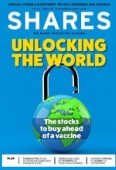Archived article
Please note that tax, investment, pension and ISA rules can change and the information and any views contained in this article may now be inaccurate.
Time to ride the bounce at Burberry

October’s encouraging return to sales growth suggests luxury goods group Burberry (BRBY) is starting to recover from the worst effects of the pandemic.
And with Covid-19 vaccine breakthroughs pointing the way to a full reopening of the global economy and a rebound in intercontinental travel, Shares believes this is a compelling entry point into the stock.
Even after a post-results bounce, shares in the London-headquartered fashion house remain 26% below the £22.05 at which they started 2020. At current levels, they sell for a shade above twenty times forward earnings estimates for the years to March 2022 and 2023 according to Refinitiv data, a significant discount to luxury goods peers.
TIME TO BAG A RARE ASSET
Famed for its iconic Equestrian Knight Device and the Burberry Check, Burberry is blessed with a strong and enduring brand, which confers pricing power and underpins high margins and, in normal times, robust cash flow generation upon the business.
The FTSE 100-listed trenchcoats-to-cashmere scarves manufacturer and seller is a long-standing holding in the Finsbury Growth & Income Trust (FGT) managed by well-followed fund manager Nick Train.
In his latest factsheet commentary, Train explained his trust wants to own more UK companies with luxury, premium or aspirational brands and this is ‘why we have thought it so important to maintain the size of our position in Burberry, through its recent share price weakness’.
CHINA DRIVES GROWTH RETURN
Much of Burberry’s sales rely on globe-trotting, free-spending Asian customers, which explains why the shares sold-off heavily as the coronavirus began to spread out from China and why the momentum Burberry had built under chief executive Marco Gobbetti was so badly disrupted by Covid-19.
Recent results, covering the six months to 26 September 2020, showed sales tumbled by 31% to £878 million, although this was better than analysts had predicted considering that Burberry began the half with 60% of its stores closed globally due to the pandemic.
Burberry did rather well to limit the first half decline in adjusted operating profit, down 75% to £51 million, while also delivering high double-digit online sales growth in the second quarter.
With the majority of Burberry’s stores reopened by the end of June, like-for-like store sales were down 6% in the second quarter, representing a strong sequential improvement on the 45% slump suffered in the first quarter. Encouragingly, the recovery has further accelerated in the last two months; September’s comparable store sales were down low single digits before turning positive in October.
During the second quarter, Burberry generated strong double-digit growth in mainland China, Korea and the US, though the virus continues to impact sales in EMEIA (Europe, the Middle East, India, and Africa), Japan and South Asia Pacific.
The leather goods, dresses and knitwear maker is seeing a strong response to its brand among social media-savvy new and younger customers. In mainland China, where Burberry has seen significant digital adoption, the company has even opened its first social retail store in Shenzhen Bay in an exclusive partnership with Chinese internet giant Tencent, which should boost brand awareness over time.
RISKS TO CONSIDER
Burberry, which will review reinstating the dividend at the end of the current financial year, remains ‘conscious of the uncertain macro-economic environment caused by Covid-19’, mindful that more than 10% of its global stores are currently shuttered following the recent lockdowns in EMEIA.
Thankfully, Burberry has the balance sheet strength to weather the remainder of the crisis. As at 26 September, Burberry’s 12-month adjusted net debt-to-adjusted EBITDA ratio was 0.9 times and remained inside management’s target range of 0.5 times-to-one times despite the impact of the pandemic.
Investors should also note that French luxury goods groups Hermes and Kering have both recently beaten third quarter sales forecasts amid strong demand in Asia and the US, suggesting a tentative recovery from the pandemic and its punishing lockdowns is now underway.
Furthermore, France’s LVMH has finally ended its pandemic-induced dispute with Tiffany and agreed to buy the engagement rings purveyor for a lower-than-originally agreed $15.8 billion.
Rather than walk away, Dior-to-Louis Vuitton owner LVMH salvaged the luxury sector’s biggest-ever deal, which demonstrates just how highly prized luxury brands remain. This mega-deal might even spur further industry consolidation once the global economic picture improves, and a lunge for Burberry certainly shouldn’t be ruled out.
Important information:
These articles are provided by Shares magazine which is published by AJ Bell Media, a part of AJ Bell. Shares is not written by AJ Bell.
Shares is provided for your general information and use and is not a personal recommendation to invest. It is not intended to be relied upon by you in making or not making any investment decisions. The investments referred to in these articles will not be suitable for all investors. If in doubt please seek appropriate independent financial advice.
Investors acting on the information in these articles do so at their own risk and AJ Bell Media and its staff do not accept liability for losses suffered by investors as a result of their investment decisions.

 magazine
magazine











